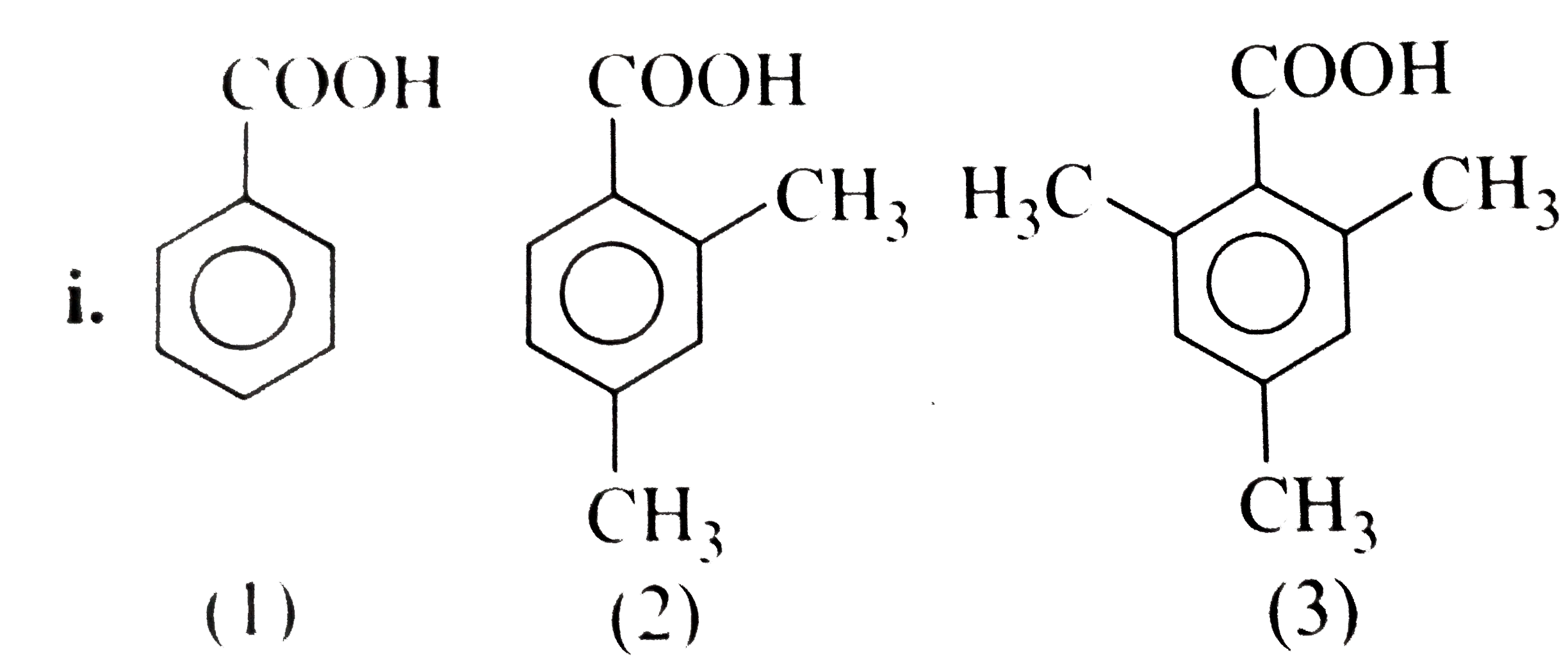The order of reactivity of CH3CHO,CH3COC2H5andCH3COCH3 is
CH3CHO>CH3COCH3>CH3COC2H5
C2H5COCH3>CH3COCH3>CH3CHO
CH3COCH3>CH3CHO>C2H2COCH3
CH3COCH3>C2H5COCH3>CH3CHO
The correct Answer is:A
Aldehydes are more reactive than ketones.
Topper's Solved these Questions
- BOOK - NCERT FINGERTIPSCHAPTER - ALDEHYDES, KETONES AND CARBOXYLIC ACIDSEXERCISE - MCQs( CHEMICAL REACTIONS )2videos
ALDEHYDES, KETONES AND CARBOXYLIC ACIDS
- BOOK - NCERT FINGERTIPSCHAPTER - ALDEHYDES, KETONES AND CARBOXYLIC ACIDSEXERCISE - MCQs(CHEMICAL REACTIONS )11videos
ALDEHYDES, KETONES AND CARBOXYLIC ACIDS
- BOOK - NCERT FINGERTIPSCHAPTER - ALDEHYDES, KETONES AND CARBOXYLIC ACIDSEXERCISE - Physical Properties4videos
ALDEHYDES, KETONES AND CARBOXYLIC ACIDS
- BOOK - NCERT FINGERTIPSCHAPTER - ALCOHOLS,PHENOLS AND ETHERSEXERCISE - Assertion And Reason14videos
ALCOHOLS,PHENOLS AND ETHERS
- BOOK - NCERT FINGERTIPSCHAPTER - AMINES EXERCISE - NCERT EXEMPLER PROBLEMS1videos
AMINES
Similar Questions
Knowledge Check
- Question 1 - Select One
Correct order of reactivity of CH3CHO,C2H3COCH3andCH3COCH3 is
ACH3CHO>CH3COCH3>CH3COC2H5BC2H5COCH3>CH3COCH3>CH3CHOCCH3COCH3>CH3CHO>C2H5COCH3DCH3COCH3>C2H5COCH3>CH3CHO - Question 2 - Select One
The reactivities of CH3Cl,CH3CH2CH2ClandC6H5Cl are in the order
ACH3Cl>CH3CH2CH2Cl>C6H5ClBCH3CH2CH2Cl>CH3Cl>C6H5ClCC6H5Cl>CH3CH2CH2Cl>CH3ClDCH3Cl>C6H5Cl>CH3CH2CH2Cl - Question 3 - Select One
The acid strength of active methylene group in
(I) CH3COCH2COOC2H5 (II) CH3COCH2COCH3
(III) C2H5OOCCH2COOC2H5, decreases as :AI>III>IIBI>II>IIICII>I>IIIDIII>I>II
Arrange the following in decreasing order of nucleophilic addition
CH3CHO,CH3COCH3,HCHO,C2H5COCH3View Solution(a) Distinguish between PhCOEt and p−MeC6H4COMe by a chemical method.
(b) Arrange the following in the order of increasing reactivity towards nucleophilic addition reactions.
(i) CH3CHO,C6H5COC6H5,CH3COC6H5,CH3COCH3
(ii) CH3CHO,CF3CHO,CH2=CHCHOView Solutiona. Acid halides, anhydrides, esters and amides, all of them contain (C=O) group but none of them gives test for (C=O) group, i.e., they do not form oximes, hydrazones, and DNP derivatives, etc. Why?
b. Arrange the following in the decreasing order of nucleophilic addition.
i. (1)−CHO
(2)−COCH3
(3)−COOH
(4)−COCI
(5)−CONH2
(6)−COOCH3
(7)−COOΘ
ii. (1)CH3CHO
(2)CH3COCH3
(3)HCHO
(4)CH2H5CH2COCH3
iii. (1)CH3COCH3
(2)C6H5COCH3
(3)C6H5COC6H5
(4)C6H5CH2COCH3
iv. (1)C6H5CHO
(2)ρ−CH3.C6H4.CHO
(3)ρ−OH.C6H4.CHO
(4)ρ−NO2.C6H4.CHO
(5)ρ−CI.C6H4.CHO
v. (1)HCHO
(2)CH3CHO
(3)CH3COCH3
(4)CI3CCHO
c. Arrange the following in the increasing order of ease of hydrolysis.
(1)CCH3COOC2H5
(2)CH3COCI
(3)(CH3CO)2O
(4)CH3CONH2
d. Arrange the following in the increasing order of ease of acid-catalysed esterification of:
i.
ii. (1)CH3CH2COOH
(2)(CH3)2CHCOOH
(3)(CH3)3CCOOH
iii. (1)CH3CH2CH2OH
(2)CH3CHOHC2H5
(3)(CH3)2C(OH)C2H5
e. Arrange the following esters in decresing order of ease of alkaline hydrolysis.
i. (1)HCOOCH3
(2)CH3COOCH3
(3)(CH3)3CCOOCH3
(4)(CH3)2CHCOOCH3
ii. (1)CH3COOCH3
(2)CH3COOC(CH3)3
(3)CH3COOCH(CH3)2
(4)CH3COOCH2CH3
iii. (1)C6H5COOCH3
(2)ρ−CH3O−C6H4−CCOOCH3
(3)ρ−NO2−C6H4−COOCH3
(4)ρ−Cl−C6H4−COOCH3View SolutionThe acidic strength of active methylene group in
I. CH3COCH2COOH2H5
II.CH3COCH2COOH3
III. C2H5OOCCH2COOC2H5View SolutionThe IUPAC name of CH3CH2CH2CH(CH3)COCH3 is
View Solution

